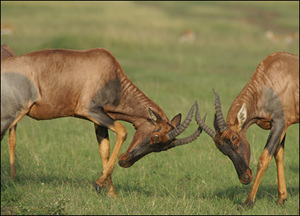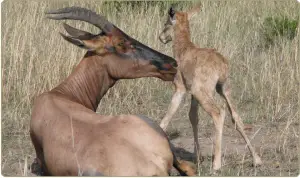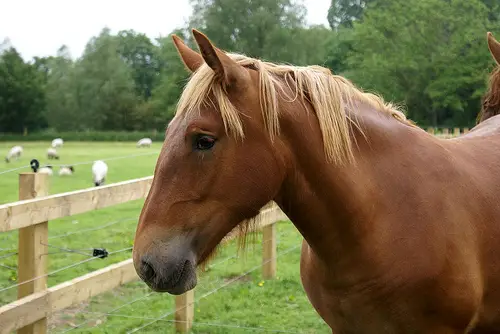Topi
The Topi is one of the largest antelopes inhabiting the African savannas and is also possibly the fastest one. When running from danger, these antelopes can even jump over each other. Their natural habitat are the African savannas from Senegal and Sudan, stretching over all the Eastern and Southern African territories.
This impressive mammal reaches a height of 100-130 cm and a length of up to 2 metres, weighing an incredible 150 kilograms. Both sexes have impressive, corded horns reaching 70 cm in length. The colouration varies from light brown to almost black, with darker hips and a black stripe stretching vertically down the head.
Topi antelopes usually inhabit in large open grassy territories with few trees and bushes. Each male leads a small group that takes a 200-400 square meter large territory. The holder of this territory has the right to mate with the females in it, thus it’s no wonder that males are very aggressive towards their rivals, and as most antelope species, the Topi use their horns when fighting.
The Topi go feed at dusk, while spending most of the day resting and digesting. Being ruminant animals, they can eat even the hardest vegetation, ruminating it multiple times to digest it. The Topi groups move from one area to another in search of better pastures. At night, when feeding, they have to be very attentive not to become prey to the predators lurking from every corner. If in danger, the Topi will always choose running instead of fighting, and very few animals can actually catch this antelope once it has started running.
As all antelopes, the Topi are a very important part in the food chain, and they’re hunted by a variety of predators. Lions are most dangerous for these animals, although they have to beware of leopards, cheetahs and hyenas, too. It’s interesting that males become victims to the predators more often than the females, which is probably because they don’t usually stick with the rest of the group and spend much of the time guarding the territory from other Topi males.
The time of the mating period depends on the weather, and it depends on the food available in the surrounding areas. At the beginning of the mating period, each male takes a small territory and tries to gather as many females as possible. After a gestation period of 7-8 months one, or rarely two calves are born. The young Topi can walk already in 15 minutes, and both the mother and her offspring return to the relative safety that is the group.
Even though humans have hunted these animals for centuries, the Topi have been able to reproduce efficiently enough to maintain a stable population and they’re currently not endangered, nor does their number seem to be on a decline.





